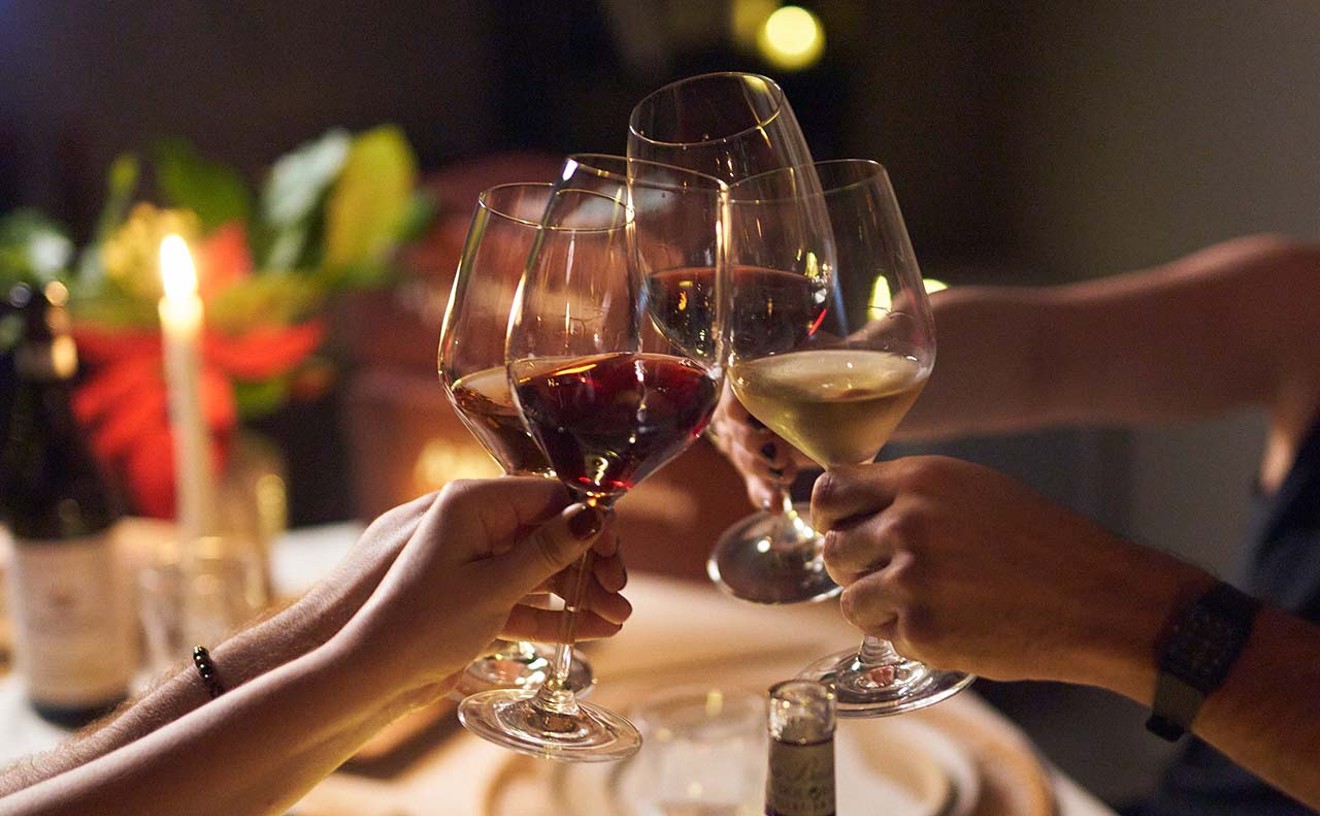When I grilled Diaz at Bambú's eventual opening party about her motives for co-owning Bambú, however, she seemed slightly shocked at the idea she might merely be an absentee owner rather than an enthusiastic diner. "I love Asian food! The truth is I got involved in this restaurant for purely selfish reasons. I spend a lot of time in Miami, and I needed someplace to eat." As an Asian-food fan, I empathized. Sure I have a few tasty take-out faves in town. But in terms of world-class Asian cuisine, Miami has a problem.
Bambú looked to be the solution, owing to the much-trumpeted involvement of yet another superstar, New World cuisine cocreator Norman Van Aken, as consulting chef. By the time Bambú finally opened, I'd been drooling for months over the menu Van Aken had faxed to me in early November, a mouthwatering assortment he nevertheless described as "fairly standard authentic Asian items -- well, as authentic as a boy from the Midwest can be -- that, with continued work, I would flesh out with more witty, unique, et cetera, offerings, to develop a menu that would be a corollary of Norman's but with Asia as her guide." Toro "flower" with osetra caviar, fresh wasabi, and Asian pear gelée standard? Better stuff to come? And, with the appointment of gifted Van Aken protégé Rob Boone as executive chef, a seeming guarantee of flawless recipe execution? Yesss!
Then again, maybe no.
It's been obvious since the first opening bash that Bambú is at least as much nightclub as restaurant, notably because of what was present (a Franco-frat party ambiance; a house soundtrack way too pumped to be conducive to conversation or digestion; and celebrities, including Diaz's less-famous film-star date Jared Leto, Latin singing star Javier Iglesias, ex-basketball star Rony Seikaly, plus limo loads of very skinny models), and what was not present: food. The place continues to be packed with rail-thin fashion-conscious folks who either are actors/models or desperately are trying to look the part.
So it's no surprise that Bambú's best food focuses on light designer dishes that don't drip on the designer duds. Sushi especially was super on all three of our visits, partially thanks to Van Aken's original culinary vision, partially to the impeccable execution of Bambú's skilled sushi chef Iwao Arai, and partially to stupifyingly luxe ingredients. Envision, for example, a piece of typical nori-encircled sushi rice topped with atypical tobiko roe, and with a generous dollop of fresh Russian beluga or osetra caviar.
Even better was a panko-crusted maki roll, a masterwork of contrasts featuring buttery raw toro, sweet yet refreshingly crunchy pickled ginger shoot, and tangy-rich XO sauce, all enclosed in seaweed and greaselessly deep-fried in a crisp coating of light Japanese rice "breadcrumbs." Just as good: a silky maki of hamachi, shiitakes, masago, and mango; and a tiger-shrimp hand roll with snapping-fresh shrimp, a light Asian chili bite, a drizzle of sweet vinegar, and an unusual but perfect Thai accent, basil.
As for the rest of the menu, here's the summary: Everything my dining partner and I eagerly tried on our first visit, practically the first hour Bambú opened, was promising enough. On my second visit weeks later, some food (notably sushi) still was terrific, but other items were problematic enough to make me feel uneasy about a rave review. And on my third visit, two months after opening, uneasiness escalated to queasiness; several dishes, in fact, were so unpalatable they verged on inedible, including one that had been so good on my first visit that I'd praised it to a visiting professional colleague, a national food editor. She sent the ill-spiced mess back.
The explanation for this puzzling reversal (promising restaurants are supposed to get better once they settle down), in my opinion, probably lies in Bambú's disassociation from Van Aken shortly after opening. The chef himself ain't talking on the record, except to say, "I have had nothing to do with Bambú's 'as delivered' food. I was paid a mutually acceptable amount of money for the up-front work I did. The personal stamp and style I would have chosen will be saved for ventures that are 'Norman Van Aken, beginning to end.'"
Oh, well.
Here's the detailed replay. Aside from sushi a first-visit standout was rock-shrimp tempura with cucumber salad, small Asian lettuces, and two sauces (refreshingly sour citrusy yuzu emulsion and a creamy mayo-type drizzle) -- a perfectly light, innovative Asian take on a classic Florida raw ingredient. Indonesian oelek sambal, kaffir lime leaf, and Thai basil gave fried chili stone crab claws striking pungency despite virtual greaselessness. Thai green curry chicken (reportedly Diaz's favorite dish) verged on too greaseless for a good ol' Southern fried chicken lover, but a kaffir lime/coconut milk bath kept the organic bird juicy. Most impressively, soy-laquered cod with honshimeji mushrooms, and chrysanthemum-leaf tempura recalled the succulent subtlety of Asian fusion pioneer Nobu Matsuhisa's signature black-cod preparation.
A second meal began positively with more stupendous sushi, this time with optional "tableside grated fresh wasabi service" -- a revelation! Once tasted, the real root's refined kick, hot yet subtly sweet, makes it hard to settle for the typical one-dimensional green paste. (Even this is generally not reconstituted powdered wasabi, as Japanese food fans here naturally assume, but a mix of regular horseradish, mustard, food starch, and green dye; most Americans have never tasted real wasabi in any form.) Unfortunately Bambú diners who order more than one round of sushi do have to settle, because one small heap of fresh wasabi came only with our table's first item; subsequent sushi was accompanied by the pseudo stuff. Also, the fresh wasabi was not grated tableside. The price has, however, gone down since Bambú's opening, from eight dollars to six.
More troubling, the toro flower was beautiful, but, as its extreme red/white bicolor made clear, it's not all toro. This prized fatty tuna-belly cut does vary in color, but always within the scale of pale to dark pink. In fact the total lack of any fat striations suggested the toro flower contained no toro whatsoever, but rather lean red tuna, pedestrian maguro, and lean white tuna -- both fresh, but both vastly cheaper fish than what was listed, wanted, and paid for. In Japan's fish markets, fatty tuna belly sells for at least four times the price of lean tuna.
Equally disturbing for the same reason (suspicion of ethical futzing in order to economize) was Bambú's "Kobe beef," featured in both a $54 main dish of shabu-shabu, and a $9 yakitori miniappetizer. The price I expected. Imported Kobe, known for its literally melt-in-your mouth texture (the Japanese cattle are hand-massaged daily) is known to connoisseurs as exorbitantly expensive but worth it. What I didn't expect was for my allegedly butter-soft beef skewer to consist of two not-quite-one-inch-square slices of thin shoe leather.
On my third visit, rock-shrimp tempura was still good. Pad thai, however, was awful. The "fresh Shanghai noodles," veggies, and super-small shrimps were all overcooked to the consistency of canned baby food: pad pablum. Further, the mush's only discernable taste was a cloying coconutlike sweetness -- no traditional peanut/cilantro/citrus/chili/fermented fish complexity, no new substitute flavor inventions. Korean scallion pancakes with maitake mushrooms and vegetable kim chee sounded great but were served soggy as wet cardboard. And to my embarrassment, the subtly sweet and spicy cod I'd so enthusiastically recommended after my first visit was this time dominated by a delirious amount of star anise: a laquered licorice lollipop.
Although I didn't retry Bambú's toro flower, I did notice it had been relabeled "Big Eye Tuna Flower," which would certainly have been a more accurate explanation of my first visit's lean tuna arrangement. I did retry the "Kobe beef" jerky, now labeled "American Kobe beef." This also seemed a more accurate description but still a disturbingly misleading one. What's inexplicable is why none of the dishes had been significantly reduced in price. The flower, in fact, had been raised from $22 to $28. The quasi-Kobe entrée's hefty $48 tag seems perhaps more understandable, since the dish had been redesigned to include a different expensive ingredient: foie gras.
On the bright side, the seven-dollar ice cream/sorbet trio was a two-outta-three-ain't-bad bargain: yuzu sorbet (bracing!), Granny Smith apple and wasabi sorbet (weird but it works!), and pistachio and saffron ice cream (weird but ...). Possibly in place of the pistachio we should have gone for palm sugar and star anise ice cream, as the waiter recommended, but we were anised out.
Service was well-meaning. Still virtually every item ordered on the second and third visits arrived simultaneously, despite deliberate instructions that five items at once was not desirable. During visit one a nervous support server repeatedly poured water into my partner's wine. But this mistake was charmingly rectified by our main server, who immediately replaced all watered wine with full complimentary glasses, and inquired, straightfaced, at the meal's end: "Would you like anything else? More water in your wine? Or maybe some wine in your water?"
There are pluses to Bambú, aside from sushi, sorbet, and a few other grazes and garnishes. The décor is impressive, especially now that the shoddy sheet-covered seating that busted butts for almost two months finally has been replaced with the comfy chairs interior designer Patrick Kennedy intended. An exotic open kitchen/sushi bar gives the main room the feel of dining in an elegantly minimalist Oriental garden, and a spectacular bamboo container garden in the narrow side corridor is almost consolation for being seated in Siberia. (Diners who really rate get main room tables, or ascend to the upstairs lounge.)
As for consistently excellent Eastern eats in Miami Beach, though, I hate to say it, because Cameron Diaz struck me as a really nice person who really does love Asian food. But I think she's gonna have to keep looking for someplace to eat.










